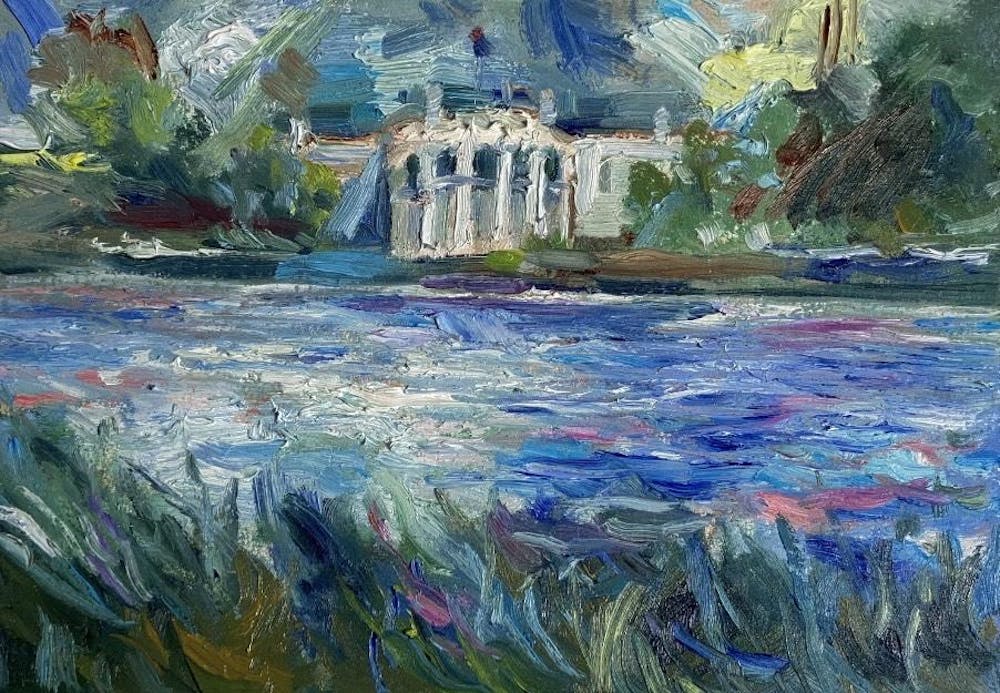This fall, the National Gallery of Art in Washington, D.C. is bedecked with pastels, broad brushstrokes and light –– the French Impressionists have arrived. While the muggy autumn weather outside is yet to cool, springtime blooms inside the gallery. I join the flow of onlookers as they peer into each frame, momentarily transfixed by the artist’s work. I stand in the shadow of Madame Monet holding her parasol atop a windy hill. Next, I gaze out at the sunbaked countryside of Cézanne’s landscapes. They all allude to reality, depicted in just a few shades of oil paint.
In the art world of 19th century Paris, to paint an impression was groundbreaking. Today, Impressionist artwork overwhelmingly appeals to the masses, rendering artists like Renoir, Degas and Pissaro beloved. In pursuit of understanding why psychologically we are drawn to this movement, I began to notice that elements of Impressionism exist in another artform –– the art of political campaigning.
Through the lens of witnessing election season on the Hill, I have concluded the following: Impressionist art is alluring because the viewer has the power to imagine and viscerally experience the scene in the painting however they wish. There is an iota of truth at its center, that hint of lifelike realism, but the overall image is varnished over in a haze of abstraction. From my point of view, the Société Anonyme would classify the campaign strategies of Donald Trump and Kamala Harris as strikingly of the Impressionist moment, since they both seem to be aggressively using broad brushstrokes to paint an image that strengthens their popularity, irrespective of their actual policy proposals. At first glance, these strategies are effective in rallying the most enthusiastic supporters. Looking only to absorb what they want to hear from their political candidates, these supporters engage with instigative sound bites, tweets, TikTok trends and slogans that reinforce their preexisting beliefs. However, upon further examination, an “impression” fails to get into all the details, including the good and the bad.
Since the origin of rhetoric, leaders have learned from their predecessors when navigating persuasive speaking. We have seen many of the techniques used by this election’s candidates before — logos, pathos, ethos, hyperbole, repetition, metaphor –– and while every speaker discusses different issues, the most charismatic conclude with a recurring aspirational quality. Both Trump and Harris discuss vision in a way that inspires hope for a better future within their respective supporter groups. An emotional response has a powerful way of energizing a crowd, galvanizing support and gaining followers.
The strategy of the Harris campaign is to emphasize joy and moving forward. The mission of Trump’s second presidency is to return greatness to our nation. Both candidates talk of their version of an aspirational dream so that listeners can grab onto it and feel included in a communal effort of achieving a better future. However, the lack of focus on the actual policies that might allow for this better future makes it hard for voters to imagine how either candidate could realistically achieve these dreams.
This federal election cycle has felt like one drawn-out spectacle. With theatrical debates and conventions, a Hollywood-style introduction of a new Democratic nominee and absurd memes circulating the internet, this political race in many ways has been deficient in substantial policy material to engage with. For example, each candidate’s detailed action plan to address key issues like the economy and the border crisis are still unclear to many voters, while the general sentiment of their stance is widely known. When you think about Impressionist paintings, how does the subject content make you feel? When in the National Gallery of Art exhibit, I felt a sense of uninterrupted bliss. Impressionist paintings never deal with actual human suffering; they focus on idyllic scenes of contentment and leisure. Today’s political techniques gloss over real world issues in the same way. Their rhetoric is aesthetically pleasing to voters and elicits strong feelings and emotions, but neither candidate is making strong policy-backed claims that support their overarching messages.
Do these campaigns and their focus on idealized messaging feel more pronounced now, or have they been this way for years? Perhaps the methodology of persuasive speaking will never change. Regardless, it is important to remain critical of rhetorical strategies because they set a precedent for future elections. If we continue on this path, we may veer away from the original intentions of the electoral system. The right to civic engagement and informed voting are individual freedoms that we should preserve, so the public must continue to vouch for realism instead of buying into varnished impressions of reality. Though there will always be those who would rather bask in the uninterrupted bliss of an Impressionist exhibit, it is our responsibility as patriots to dig past the twinkling rhetoric and decide whether there is any substantive meaning and plan for action behind our politicians’ words.





